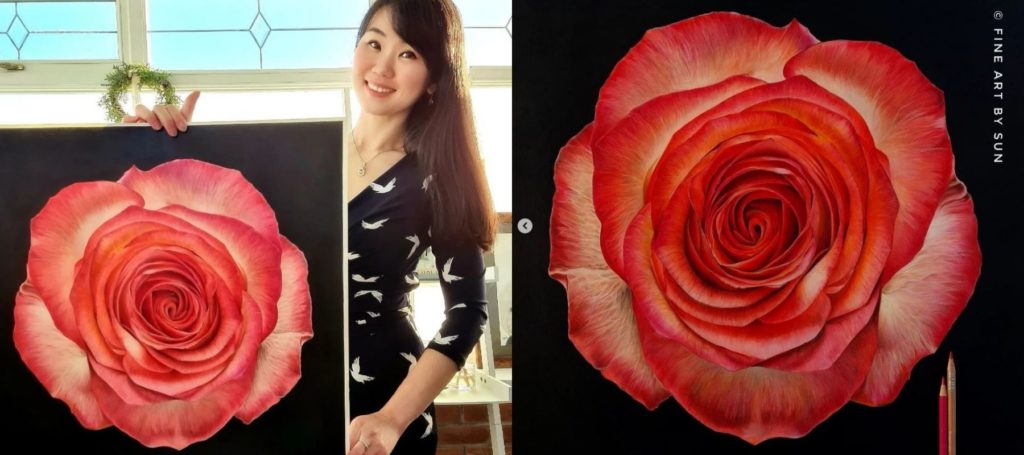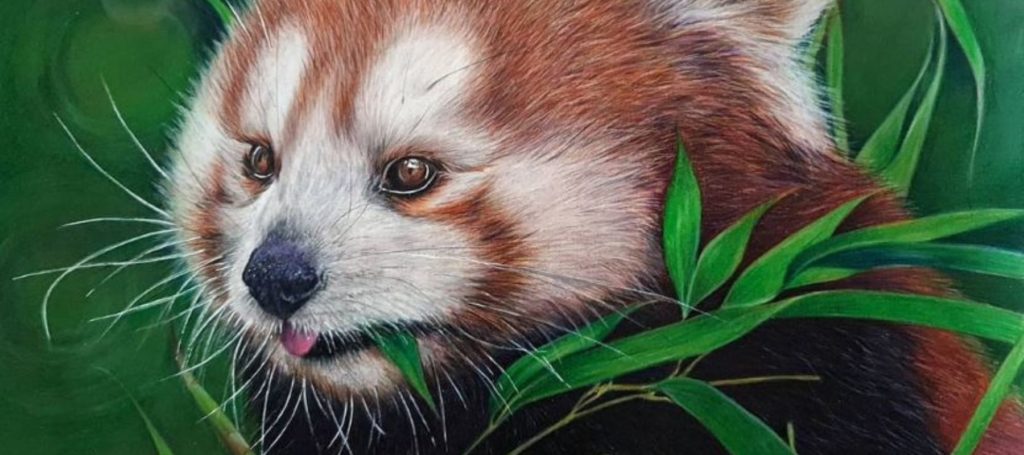How to create realistic drawings using Faber-Castell Polychromos and Derwent Lightfast Pencils
Sun | 15th May 2022

My name is Sun, and I am a self-taught colour pencil artist based in South Wales, UK. I have been a professional artist since 2018 predominantly working on pet portraits using colour pencils.
I create highly detailed pencil portraits of pets, wildlife and nature subjects such as flowers and insects capturing as much detail as possible to bring the subject to life. Creating artwork using colour pencils can be very time consuming but gives you full control over the detail, depth and accuracy of the subject like no other medium I have used. This lightweight, portable and relatively mess free medium comes with me wherever I go allowing me to start drawing when inspiration strikes.
Top 6 materials for coloured portraits
I use many materials and items to create my work but the main ones I primarily use after many cycles of testing are;
1. Fabriano Artistico HP Watercolour paper 300gsm/140lbs
4. Slice Manual Pen Cutter 10513
My favourite pencils are the Faber-Castell Polychromos and Derwent Lightfast Pencils. These two colour pencils complement each other perfectly bringing out their best qualities when used together. Faber-Castell Polychromos are the most well loved Oil-based colour pencils by many artists including pet portrait artists and once you have used them you realise why they are held in such high regard. Their cores are very strong meaning they can be sharpened to a very sharp point allowing you to handle extreme detailed aspects such as fur textures. The colour manages to feel soft and thick while still being easy to work with. Also, with a huge choice of 120 colours and multiple sets available, the artists are able to achieve just about any colour approach imaginable.
Derwent Lightfast pencils are also Oil-based pencils but their texture is waxier. The strokes of the pencil are buttery smooth which is perfect for blending and highlighting. For how I like to layer and blend, Derwent Lightfast pencils work perfectly. This is due to their texture allowing me to create the perfect foundation and blend with ease throughout the creation of my work. The lead is creamy yet strong enough to sharpen into a very good point for finer details as well. I was also blown away by their green and purple range of colours as the pigments were so vibrant and really made my work jump off the paper when I used them.
8 Tips for creating realistic colour pencil drawings

1. Understanding layers and lighting
When it comes to drawing a realistic image, understanding how the portrait will be built up is very important. When working with pencils you need to remember that you will be using multiple layers to create depth and realism. This starts with building the foundation you will then build your detail upon.
2. Use a light hand when layering
It is important you don’t lose the tooth of the paper when you draw. If you use light pressure, you will be able to add more colour on the paper. A tooth on the paper will hold onto pencil pigment, making it easier to layer and blend colours whilst also making the colours appear brighter on the surface. Be patient and layer your colours to develop more depth from your image. This is very important as if you lose the tooth of the paper, you cannot get it back.
3. Find the right paper for you
Look for paper that is acid-free, as this means that it is archival quality. Paper that is thicker is better in my opinion and it isn’t likely to tear when erasing or adding many layers. I am working with Fabriano Artistico HP Watercolour paper 300gsm/140lbs and it has been perfect for me. It has never failed me, not even once. I recommend you test different types of paper to find your perfect drawing partner.
4. Start drawing light to dark
If you draw with a light colour over a dark colour you won’t get complete coverage. For that reason, start with your light colours and slowly layer in the darks. Dark pencil marks can be more difficult to remove from the paper so be careful. Light colours are far more forgiven so get this stage right before you start adding in the darker tones.
5. Push past the “ugly” stage
Every piece of artwork has its own ugly stage. Don’t worry and carry on. Creating artwork using coloured pencils can be very time consuming and can easily become stressful. Take a break, have a cuppa and a biscuit and go back to your drawing board to carry when you are ready. Creating artwork takes time and a lot of patience. Don’t give up and take every opportunity to learn and enjoy the end result. Every artist thinks they can do better which is great as this is how we keep learning.
6. Mix colours to create the hues, tones and shades that you want
You won’t have the perfect pencil in your box for every colour that you want to render on the paper. You will need to create some of these colours by thoughtfully blending and mixing the colours you do have. Don’t be afraid to experiment and capture these on test papers for future reference.
7. Don’t be afraid to use solvents
I often use Zest-it pencil blend to speed up the blending process. It helps to spread the colour out over quite a large area. This is perfect for subtle skin tones on a human or foundation for an animal’s fur.
8. Fixative
When I finish my drawings, I like to use Winsor & Newton Fixative to protect my drawing for the longest possible time. I tend to apply a couple of coats and make sure all the surface area is covered.[/vc_column_text][vc_empty_space height=”20″][/vc_column][/vc_row][vc_row][vc_column][vc_column_text]
Step-By-Step tutorial for using Derwent Lightfast colored pencils

I have solely used Derwent Lightfast pencils to create a panda drawing that shows off the texture that can be achieved whilst using these pencils. The end result was very satisfying as was the entire drawing process.
Watch this video for the step-by-step tutorial.
Author Sun
Hi, my name is Sun and I am a professional portrait artist based in South Wales. I am a commission-based artist specialising in pet portraits for clients all over the world. I also create original artwork based on wildlife and nature to capture those precise moments all around us through the medium of colour pencil.
I work very closely with my clients to ensure I am capturing their little fur babies in order to deliver memories that will last a lifetime. I also work closely with local photographers capturing unique subjects in a Welsh setting. I love creating unique pieces of art where the colour bursts through the paper leading to a number of different original collections.
I am a self-taught artist who loves to learn and share their work through Instagram, Facebook and YouTube. Becoming an artist has allowed me to be part of a wonderful worldwide community of fellow artists sharing my vision of the world around me.
